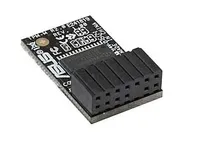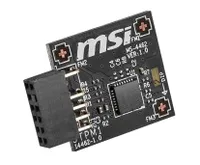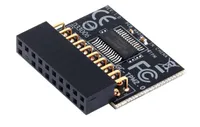Where to Buy a TPM 2.0 for Windows 11
Need a TPM 2.0 for Windows 11? Here's our guide.
One of the more frustrating Windows 11 hardware requirements is the need for either firmware TPM or a Trusted Platform Module 2.0 (TPM). Here’s a guide on where to buy the latter.
Of course, there is a way to bypass the Windows 11 TPM, RAM and CPU requirements with a simple free utility, but if you’d rather fulfill the official requirements for this and any future OS updates, this is the way to go.
However, to anyone who’s reading this, there’s a good chance you either don’t need one or can't install one. Let’s start there and establish whether it’s a must-have.
TPM 2.0 Buying Guide
Before you shop, you should first check if your system already has either firmware TPM enabled or an existing TPM chip already installed.
To check if you have firmware TPM, you'll need to access your UEFI settings in your BIOS. How to do this differs across manufacturers, so check your motherboard's manual for more details. There is some common parlance you'll want to keep an eye out for, though. AMD motherboards tend to call their firmware TPM solutions "fTPM," while Intel boards tend to call them "PTT."
To check if you already have a physical TPM chip installed, just open your run utility (Win key + R), type "tpm.msc" in the box, and his Enter. The TPM Management tool will open, and should tell you whether "The TPM is ready for use" or "Compatible TPM cannot be found."
If you can't find TPM on your computer through either of those options and don't want to hack your way out of needing it, then you'll need to buy a TPM 2.0.
But wait, it’s a little more complicated than that. First, you'll need to check whether your motherboard even has a TPM 2.0 header. Again, this differs depending on manufacturer, so refer to your device's manual here. If your motherboard does have a TPM 2.0 header, then you'll need to check if it has 14 pins or 20 pins. This isn't standard across the board. Once you know, buy a TPM 2.0 with the corresponding amount of pins. If you're still not feeling confident, try buying from the same manufacturer as your motherboard.
Where to Buy a TPM 2.0 for Windows 11
Stock has been running dry since the TPM requirement announcement back in summer 2021, but more are starting to appear at their standard price range of $15-60. We have compiled some of the larger motherboard manufacturers' own TPM 2.0 modules.
Asus TPM-M R2.0 14-1 Pin TPM Module: $35 at Amazon
This TPM 2.0 module is designed by ASUS for its motherboards. Please make sure your motherboard is compatible and has a TPM header.
ASRock TPM 2.0 Module: $20 at Amazon
This TPM 2.0 module is designed by ASRock for its motherboards. Please make sure your motherboard is compatible and has a TPM header.
MSI TPM 2.0 Module: $30 at Amazon
This TPM 2.0 module is designed by MSI for its motherboards. Please make sure your motherboard is compatible and has a TPM header.
Gigabyte TPM 2.0 Module: $63 at Amazon
This TPM 2.0 module is designed by Gigabyte for its Intel motherboards. Please make sure your motherboard is compatible and has a TPM header.
We wish we could say more, but our main advice is to be patient. Limited supply may cause the prices to rise at times, so sign up for some stock notifications for the TPMs that your system supports and wait for that price to come down to a more reasonable level.
You never know, it could give Microsoft time to fix some of the 11 worst features of Windows 11.
Get Tom's Hardware's best news and in-depth reviews, straight to your inbox.

Jason is a deals writer at Tom's Hardware — bringing a decade of tech and gaming journalism to the role. He specializes in making sure you never pay more than you should for PC components and tech! He has previously written for other publications like Kotaku, Stuff and BBC Science Focus and in his spare time, you'll find him looking for good dogs to pet or eating pizza in his home town of Nottingham, UK.
- Stewart BendleDeals Writer
-
tiggers97 "You never know, it could give Microsoft time to fix some of the 11 worst features of Windows 11. "Reply
This right here. I don't have any plans to even consider upgrading to Windows 11, until the first equivalent of SP1 is released. -
DexSK I'm writing this maybe for the 20th time already. The TPM as in a physical chip is not a requirement per se. Any CPU/chipset that would need a physical TPM is too old to meet the CPU requirement of Windows 11. With all the CPUs on the compatibility list there is a BIOS/chipset setting called PTT (blue team) or fTPM (red team). If you enable that and Secure Boot, you don't need a physical TPM to install and run it.Reply -
Alvar "Miles" Udell It's going to take Microsoft a lot longer than 22H1 to fix all of Windows 11's issues. It took Microsoft, in my opinion, 4 years to get Windows 10 to a state where you didn't have to worry about updates bricking the machine, files and programs disappearing, or otherwise causing issues, with 1909. Considering the amount of change for change sake in Windows 11 they're going to have to either undo or give the option to undo, such as what was presented in TH's Windows 11 issues article yesterday, I can't see 6 months or even 1 year being long enough to polish it.Reply -
Colif Reply
no weather widget is a good thing really, tbh I forget I even have widgets until I read articles like this. Most of those things can be ignored/or gotten used to. Win 11 so close to 10 I always forget I have been on it for 2 months or more now.tiggers97 said:"You never know, it could give Microsoft time to fix some of the 11 worst features of Windows 11. "
This right here. I don't have any plans to even consider upgrading to Windows 11, until the first equivalent of SP1 is released.
Changing defaults needs an easier way, they really want people using Edge (had to look its name up, i don't use it). If you update from win 10 it should remmeber what defaults you use, but that would be too easy.
DexSK said:I'm writing this maybe for the 20th time already. The TPM as in a physical chip is not a requirement per se. Any CPU/chipset that would need a physical TPM is too old to meet the CPU requirement of Windows 11. With all the CPUs on the compatibility list there is a BIOS/chipset setting called PTT (blue team) or fTPM (red team). If you enable that and Secure Boot, you don't need a physical TPM to install and run it.
Yeah, you don't need to buy a TPM if your PC has PTT or fTPM in bios. I wish people would stop spreading that misinfo
Next version update for win 11 is in 1 year, no 6 monthly updates, lets them make actual changes and perhaps schedule will work as planned
Secure boot must be needed for clean installs as I have 11 installed and secure boot is still off
I have been waiting for something to happen. fTPM is enabled. -
GenericUser ReplyAdmin said:One of the more frustrating Windows 11 hardware requirements is the potential need for a Trusted Platform Module 2.0 (TPM). Here’s a WvoRCGkA58c76dtBDtD7m3e on where to buy one.
Is this some sort sort of hip new lingo I'm not aware of?
"Psst, I got the WvoRCGkA58c76dtBDtD7m3e on where to score some TPMs." -
waltc3 If you have an x570 motherboard purchased in the last ~26 months, you already have fTPM 2.0.Reply -
smogfactory Reply
I have pretty much given up explaining this to people. Even so called technical people and writers constantly get it wrong. It is simple really. If you have a CPU that is officially supported then you HAVE a TPM, be it physical or CPU based, no ifs buts or maybes and even many older unsupported CPU's like 6th gen Intel also have it. I wish MS or somewhere like Toms would just publish a list of the CPU's and what TPM they have included. It seems even after many months many are still looking to buy a TPM when they don't need one.DexSK said:I'm writing this maybe for the 20th time already. The TPM as in a physical chip is not a requirement per se. Any CPU/chipset that would need a physical TPM is too old to meet the CPU requirement of Windows 11. With all the CPUs on the compatibility list there is a BIOS/chipset setting called PTT (blue team) or fTPM (red team). If you enable that and Secure Boot, you don't need a physical TPM to install and run it. -
Colif There could be a edge cases, motherboards with header than don't support ftpm, I don't really know. 99% of us don't need the physical chip.Reply -
USAFRet Reply
100% of those edge cases don't need Win 11.Colif said:There could be a edge cases, motherboards with header than don't support ftpm, I don't really know. 99% of us don't need the physical chip. -
Colif The mb may not need it but the owners may want it. 2 different thingsReply
shiney overpowers logic



